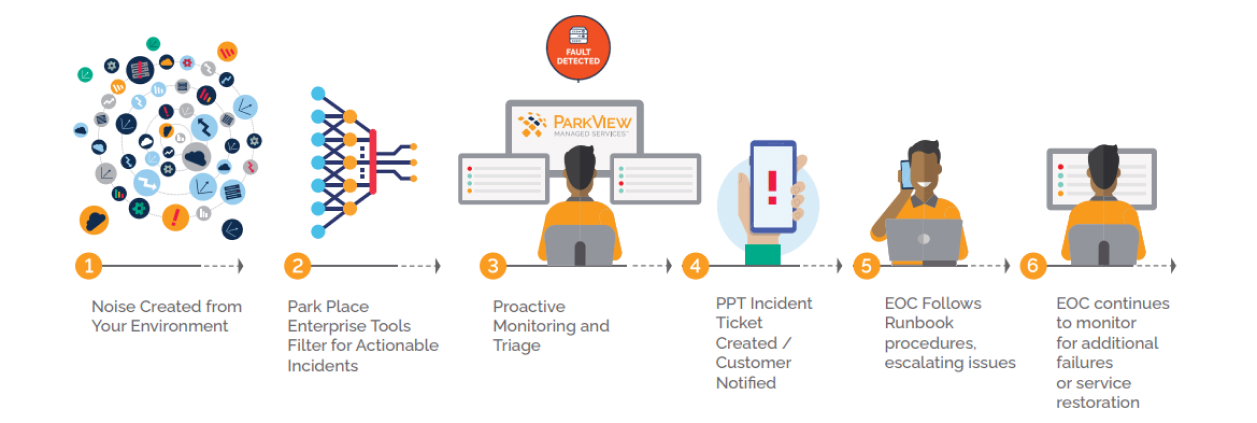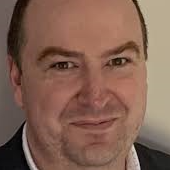Outsourced NOC Services – Benefits and Choosing the Right Partner
ParkView Managed Services
Every IT team is looking to avoid network downtime. Any amount of downtime can be costly, not just financially, but also from the time spent identifying the root cause of outages.
While managing the network via a network operations center is a responsibility often taken in-house, there is a growing trend of organizations outsourcing their IT and network processes to a third party.
If you are exploring the option of an externally managed network operations center, this guide will provide you with all the information you need, allowing you to make an informed decision on whether this approach is right for your business.
Highlights
- The most common difficulties with managing a network operations center stem from alert fatigue, monitoring availability, expertise and patching technologies.
- Organization size, staff skills and costs are three important factors in deciding between in-house NOC and outsourced NOC services.
- Once an external NOC partner is selected, the full onboarding process is critical to ensure long-term success between both parties.
Jump-to Section
What is a Network Operations Center?
What are Outsourced NOC Services?
Top 5 NOC Monitoring Challenges
5. Process Management and Maturity
In-house NOC vs Outsourced NOC
Outsourced NOCs Considerations
What to look for when Considering NOC Service Providers?
What to Expect During Outsourced NOC Monitoring Services Onboarding
Choosing the Right Partner to Manage your Network Operations Center
What is a Network Operations Center?
A network operations center (NOC) is a centralized monitoring control center, where IT managers oversee and maintain network infrastructure. It can be a small, single location where staff are made available 24/7, or it can span multiple locations, including virtual instances.
The NOC’s core responsibility is enabling systems to perform optimally. This includes identifying — and resolving — any issues, and offering guidance to keep processes operating at peak efficiency.
Nowadays, companies are commonly hosting virtual NOCs, where staff working from home have access to remote monitoring screens, rather than being physically located in the centralized command center. The NOC monitoring process can be more manageable with one or two screens at home, rather than multiple screens, and greater ”noise,” within a physical network operations center.
What are Outsourced NOC Services?
Outsourced NOC services, or NOC as a service (NOCaas), is when a third-party manage part, or all, of an organization’s network, taking care of the complexity from managing a network operations center.
Outsourced NOCs may only manage a small subset of internal NOC services such as monitoring notifications, managing firewalls, security patch updates or configuring databases. However, a subcontracted NOC team can involve complete end-to-end network management, taking control of the whole environment.
An outsourced network operations center is particularly useful for organizations that may not have the resources, expertise, or desire to maintain their own network operations center. By outsourcing these services, companies can focus on their core business while ensuring optimal efficiency and security of their IT infrastructure.
Specific, older, technologies are a key consideration when it comes to NOC outsourcing. Managing Unix, for example, is a skill that is becoming rare within the IT industry with many long-standing Unix engineers thinking of retirement and younger employees often wanting to focus on the latest technologies. This will frequently be managed by a NOC partner instead, as they will have the sufficient level of skill and expertise to manage more aging operating systems.

Top 5 NOC Monitoring Challenges
Now that we know what a network operations center is and how its functions can be managed by an external provider, it is time to turn our attention to the most common difficulties with NOC monitoring.
1. Alert Fatigue
Alert fatigue is often considered the biggest challenge concerning NOC monitoring. It regularly stems from when an outdated or non-optimally configured tool is used, or the monitoring tool doesn’t have an AI engine built in, this can then lead to repetitive alerts regarding the same subject.
For example, a router might go down in a Chicago data center and this may prompt other routers in the US to signal a notification for a similar problem. Ideally, a single incident should be raised that correlates to any number of alerts, which makes it easier to identify network faults.
2. Time and Resources
Another difficulty when managing network operation centers is time and resources; essentially having people available to do the monitoring job at hand.
What is commonly seen today is multi-skilled employees, who have a breadth of responsibilities within the IT team, not primarily focussing on NOC monitoring. They may be a network engineer, but now regularly taking on the monitoring aspect to ensure operations are running smoothly.
A lot of companies are saving time and short-term costs by not employing dedicated specialists to oversee NOC monitoring; however, it is leading to an inefficient use of employee’s resources.
3. Expertise
With anything as complex as NOC management, there must be a high degree of staff expertise to manage and observe intricate network functions.
A key concept of expertise in this context is interpreting alerts. Going back to the above example of the router going down in Chicago, expertise is needed to correlate hundreds of events that pop up suddenly and be able to pinpoint why the one single router has gone down. Without expertise, minor faults can remain undiscovered, leading to network outages.
4. Managing Toolsets
The fourth monitoring challenge for the NOC is keeping on top of tool sets, to ensure they are fit for purpose and configured correctly.
Additionally if companies have their own tool set, it needs to be regularly updated to remain protected against vulnerabilities. With unpatched vulnerabilities accounting for 60% of company data breaches, leaving systems unpatched is a risk not worth taking.
5. Process Management and Maturity
Process maturity may seem simple at face value, but in reality, it is not. Deciding what to do in the face of a major network problem is a big deal; how do you get from an alert to the right person on the phone, and how do you make sure that same process always happens efficiently, correctly, and within a specific timeframe?
To put it simply, you’re not always going to fix something for a customer on the phone, but you need to provide great customer service regardless, and in a way that that steers the customer away from frustration that something is broken. The key is how your NOC integrates with the rest of your organization. You should be able to present to executive leadership that the NOC is a valuable component of the overall business model, and the cost is justified.
In-house NOC vs Outsourced NOC
There is a lot to consider for both in-house NOCs and a NOC-as-a-service offering. Ultimately, it depends on what companies require out of each service, to make sure the right network management approach is taken.
Outsourced NOCs Considerations
When considering outsourced network management, some key aspects need to be first accounted for, to ensure this approach is compatible with existing network operations.
Organization Size
The extent to which outsourced NOC services are needed will depend on the size of the organization.
Smaller organizations that are used to having a multi-skilled NOC team, where staff often look after both end-user support and critical infrastructure, may lose the flexibility of in-house staff being able to resolve a helpdesk issue immediately, if the NOC processes are outsourced. On the other hand, smaller companies can also gain the ”already-in-place-governance” of an outsourced NOC, where the policies and procedures are well established and can be applied to virtually any customer.
Staff Skills
Level 1 in-house NOC positions are frequently filled by inexperienced employees, such as recent school graduates, who are looking for their first step into the IT world. This generally leads to relatively high levels of staff turnover, as they look to progress to more specialist or higher-skilled roles. With staff turnover comes the need for back-filling the positions and training the new staff – using an outsourced NOC provider removes the headache of time spent on finding the right replacements and training them appropriately.
If network systems are business critical and 24/7/365 monitoring is required, accomplishing this with an in-house team is a difficult task when accounting for various employee shift rotations, weekends, holidays, and sick time. However, most NOC providers are already performing to this availability and will be staffed appropriately to cover systems, frequently using a follow-the-sun model to ensure that daytime hours are used for the NOC team across the globe.
Costs
Long-term costs involved from NOCaas are typically much lower compared to in-house, while also being a fixed cost, which is important when considering operating expenditures.
An outsourced network operations center also protects costs against staff turnover or internal promotions. Generally, in-house NOC monitoring costs increase year-to-year because staff leave or receive promotions, causing expenditure on replacements and continued training. With outsourcing, this will not be a problem.
With a dedicated outsourced team managing a NOC, the risk of downtime should also be minimized, which in turn lowers operating costs. For this benefit to be realised, it is essential that the NOC partner carries a high level of expertise.
In-House NOC Considerations
Organization size, employee skillsets and financial costs are distinct considerations with NOC outsourcing. Let’s see how they compare to in-house NOCs.
Organization Size
Similarly to outsourcing, ease of NOC manageability in-house largely depends on the size of organization.
Smaller in-house NOCs will typically have multi-skilled engineers who manage the monitoring aspect, fix any potential issues and run IT transformation projects. Using this model, staff will frequently miss an alert while taking care of something else, but a positive of this approach is that it can lead to resolution of some issues in a quicker time as there is no requirement for a hand-off between teams.
Staff Skills
Many businesses who run small but critical environments often run lean and inexperienced NOC teams, hiring entry-level positions and providing training to enhance internal skills. For critical environments, even small ones, a team of at least six members is required to ensure 24/7/365 coverage. Running this model does enable staff to quickly learn ”on-the-job” and can therefore increase job satisfaction, but the stress and pressure to run these shifts may negate this, especially for staff with responsibilities outside of work.
Costs
Short term, it is more cost effective to run a NOC in-house, especially when 24/7/365 availability is not required from the business. Over the course of time, however, operating expenditure can increase considerably, due to re-training costs caused by staff turnover, increasing the ”eyes-on-screen” hours and potentially adding additional resources to cover new technologies.
Risk of downtime may also be increased with missed alerts due to running a lean internal team. Finally, time to resolution can be worse compared to using outsourced NOCs, due to using a multi-skilled team without specific technology experience, rather than specialist in each technology. This can lead to further financial burden.

What to look for when Considering NOC Service Providers?
Choosing a well-suited Network Operations Center provider is essential to guaranteeing efficient administration and management of your company’s network infrastructure. Providers with a proven record and relevant experience in managing similar networks are of course important, but here are some additional characteristics to look out for.
Relevant Requirements
Every company and IT team is different. With that, their criteria for a NOC as a service partner will differ, too.
If you require ”always-on” MSP NOC services, the provider must be available outside of office hours, 24/7/365. This can extend to the repair team if you are looking for a full remediation package in addition to a base monitoring service. Therefore, it’s critical to search for a partner that possesses these capabilities within their service level agreement (SLA). Global organizations should also consider partnering with an outsourced NOC with a ”follow-the-sun” model, so network operations that span the globe will be supported.
From a different perspective, global data-localization measures are increasing year-to-year, with some countries having regulatory requirements to make sure that no data whatsoever leaves the country; network monitoring operations must be aware of and prepared for this. If this is the case, a company should only want to outsource NOC functions to a provider in the same country as it is, without sharing data to external hubs around the world.
Toolsets and Adaptability
Network infrastructures often have bespoke requirements for monitoring, remediation, or management. Therefore, outsourced network operation centers must be able to meet these requirements with the tool sets they are using.
Many external providers will have their own custom tool set and the ability to make continuous changes within the tools themselves. This ensures their NOC monitoring tool is entirely compatible to the end-users’ network environment and network security patches can be made quickly and securely.
Some large partners in the outsourced network management space may not be as flexible in making changes in their tool set as they use an ”off-the-shelf” package, so this is another consideration.
Does it Save you Money?
This is perhaps the most important factor – does it save you money? There is no point in shifting NOC responsibilities to a third-party provider because you have been told it saves money.
It is important to examine current in-house costs and investigate outsourced pricing to make sure the cost savings are actually there. Performing due diligence is essential to ensure there are no hidden costs, such as getting charged if you exceed a certain number of monitoring ticket alerts per year, or the scope of service is less than your current solution and you need to pay for additional services, or pull in additional internal resources.
What to Expect During Outsourced NOC Monitoring Services Onboarding
For outsourced NOC monitoring services, the onboarding procedure is an essential step that lays the groundwork for an effective collaboration. Together, your IT department and the NOC service provider will build efficient procedures during each onboarding phase to guarantee a seamless transfer and continued support, even after onboarding has completed.
Before Onboarding
Before onboarding, a key element is making sure to have all relevant points of contacts established and your practices defined. The outsourced NOC provider should help you by collating all this information.
Be prepared to have login credentials in hand. The provider monitoring your environment will need to be able to log on with the lowest privileged credentials and gain access to the devices that are to be monitored. If they are to provide a remediation service as well, enhanced levels of credentials will also be required.
Other elements need to be planned such as identifying the runbooks; i.e., what needs to happen when something goes wrong, alert notification management and who to contact when there is an alert at different times of the day.
During Onboarding
Moving through the onboarding process, a period of ”specialist care” is required, when a technician will set up all NOC outsourcing services and ensure all are functioning accordingly. Long-term network capacity will also be planned, ensuring that resource demands are not strained in future.
During this phase, anything that needs a small tweak to make sure it is operating correctly can be worked on. Communication channels will be tested, so all parties are in close contact with each other.
After Onboarding
Outsourcing NOCs is an ever-evolving process to ensure continuous support is provided.
Changes within the network environment will always occur, so the NOC provider should adapt to these changes. An example may include a further-optimized SLA, such as faster response times if a network issue is detected, or a refresh of part, or all, of your environment, so new systems can be monitored and old systems can be removed from the service.
The ongoing open communication between both teams is vital and it is important to provide feedback in either direction.

Choosing the Right Partner to Manage your Network Operations Center
With more IT teams struggling to keep up with the bombardment of alerts from their network operations center, as well as OpEx costs continuing to climb amidst unprecedented staff resignations, many are turning to outsourced NOC solutions to enhance, yet simplify, their network management processes.
With ParkView Managed Services™ from Park Place Technologies, you will have the tools and expertise your organization requires to manage and oversee your data center. Our 7×24 NOC engineers support all major systems and provide you with incident management, patch management, remediation and ongoing management. No matter what level of service you require, you can count on our team to monitor and maintain your network and keep you abreast of any ongoing developments.
Interested in learning more about our outsourced NOC services? Contact our team today to get started.



